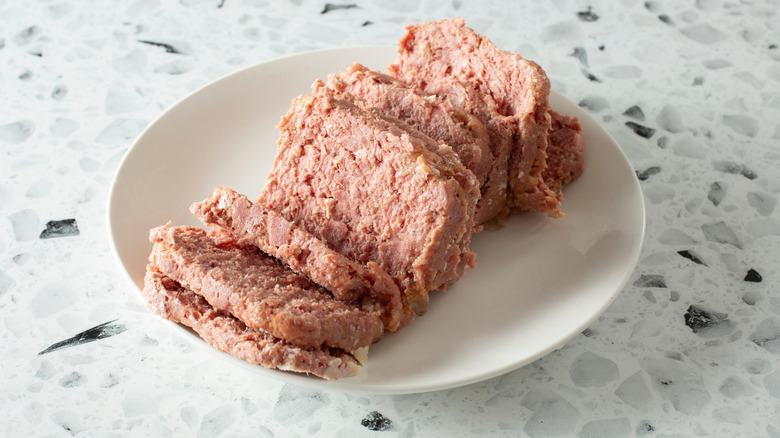Canned Corned Beef Vs SPAM: What Makes Them Different?
There's no denying the appeal of canned food. It's quick, practical, and often underrated. One of the biggest canned food myths is that the process drains away nutrition, when in fact much of it remains, especially in protein-rich options. When it comes to protein packed in a can, both canned corned beef and Spam seem to be a preferred choice for people around the globe. At first glance, their blocky shape and pinkish hue make them easy to confuse, often leading people to group them together. Yet beyond the obvious difference in taste, the two are built on very different foundations. The most defining difference is in the meat itself. Canned corned beef, as its name makes clear, is made from beef, while Spam is made from pork.
The two also carry distinct cultural histories. Canned corned beef traces its roots to Ireland, which is why it frequently graces dinner tables on St. Patrick's Day. The term itself, however, was coined by the British, who noted that the large salt crystals used to cure the beef resembled kernels of corn. Spam arrived much later. It emerged during the Great Depression, when George A. Hormel & Company of Austin, Minnesota, sought a practical way to use pork shoulder, a cut that was difficult to sell on its own. Marketed first as Hormel Spiced Ham, it was rechristened with the brisk, memorable name Spam just a year later.
Canned corned beef is brined and seasoned with more ingredients
Canned corned beef and its ingredients are slightly different from Spam, and the contrast goes beyond the choice of meat. One defining feature is brine. From its earliest origins, corned beef has always been cured with both salt and nitrites, which is where it gets its pink color from. After all, its very name has been derived from the coarse salt crystals. Spam doesn't go through that process at all. To make canned corned beef, brisket is typically cured in a salt brine with pickling spices like bay leaf, juniper berries, peppercorns, mustard seed, and coriander seed. It is then cooked, most often by boiling or steaming, before being sealed in cans for long-term storage.
Canned corned beef also has a loose, grainy texture. It is stringier with a gelatinous feel, perhaps due to the pressure cooking. While both meats have garnered fans around the world, corned beef is more widely consumed in the United States, Canada, the United Kingdom, and, of course, the Philippines. In the Philippines, it's part of breakfast culture with corned beef silog, a plate of corned beef, garlic rice, and fried egg. In the U.S, it is typically used in homey dishes like corned beef hash or with cabbage and the Reuben sandwich.
Spam contains potato starch and fewer other ingredients
Spam is smoother in texture than corned beef, closer to ham, though with a gelatinous, sponge-like feel. At its core, it's simply cooked pork shoulder and ham packed into a can. The ingredient list is notably short. Spam is made just with pork, salt, sugar, water, and sodium nitrite, which, along with the canning process, gives it a long shelf life. One ingredient you'll find in Spam but not in canned corned beef is potato starch. It was added in the 1990s to improve binding in Spam.
In the U.S., Spam is most often sliced and pan-fried, turning up at the breakfast table or as a quick snack. Since it has a wide cultural reach, you can also cook with Spam in many ways. In Hawaii, Spam is embraced as a local staple, most famously in Spam musubi, where it's tossed on rice and wrapped in nori. In South Korea, it forms an intrinsic part of budae jjigae, or army stew, where it simmers with kimchi, noodles, and whatever else is on hand. There, Spam has even taken on the role of a gift, and is commonly exchanged during holidays in boxed sets. Though far from the same, both Spam and corned beef have one thing in common. They can be savored straight from the can, which perhaps works for most in more ways than one.


